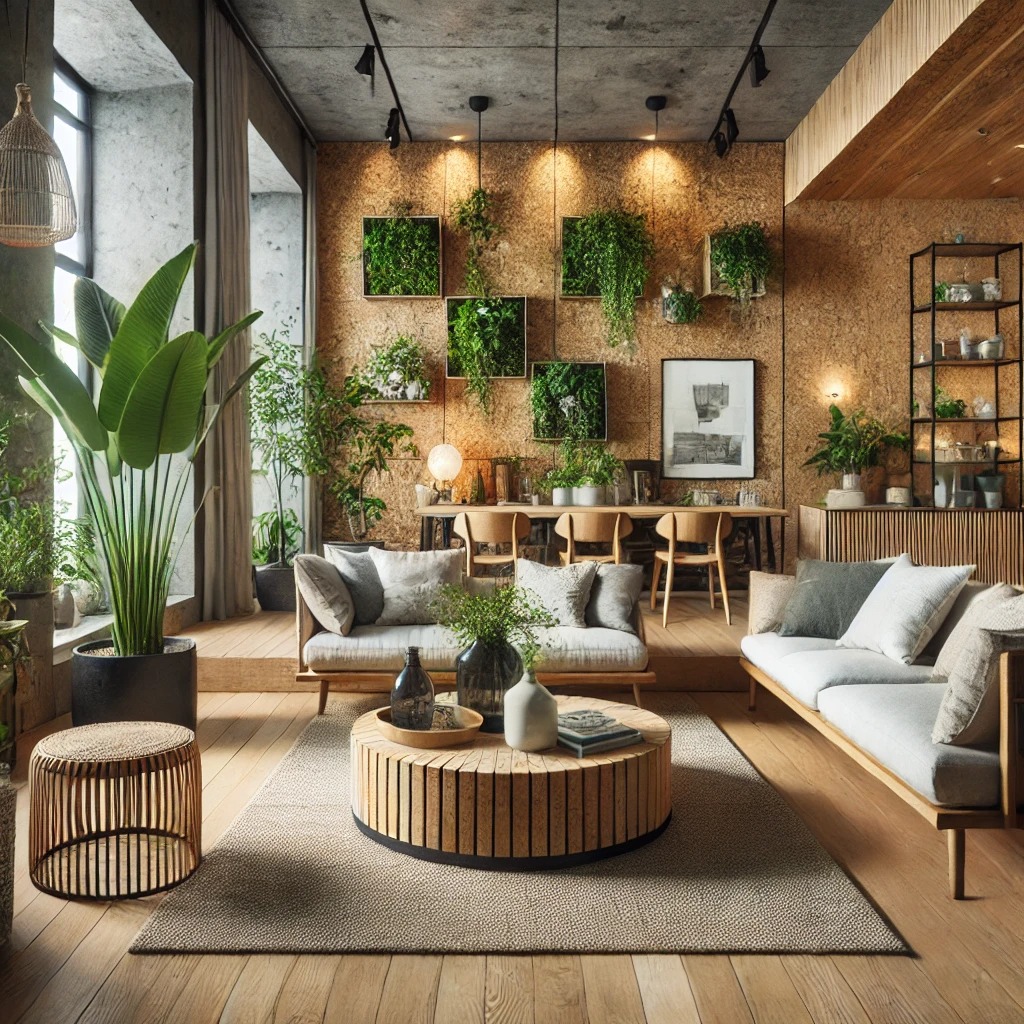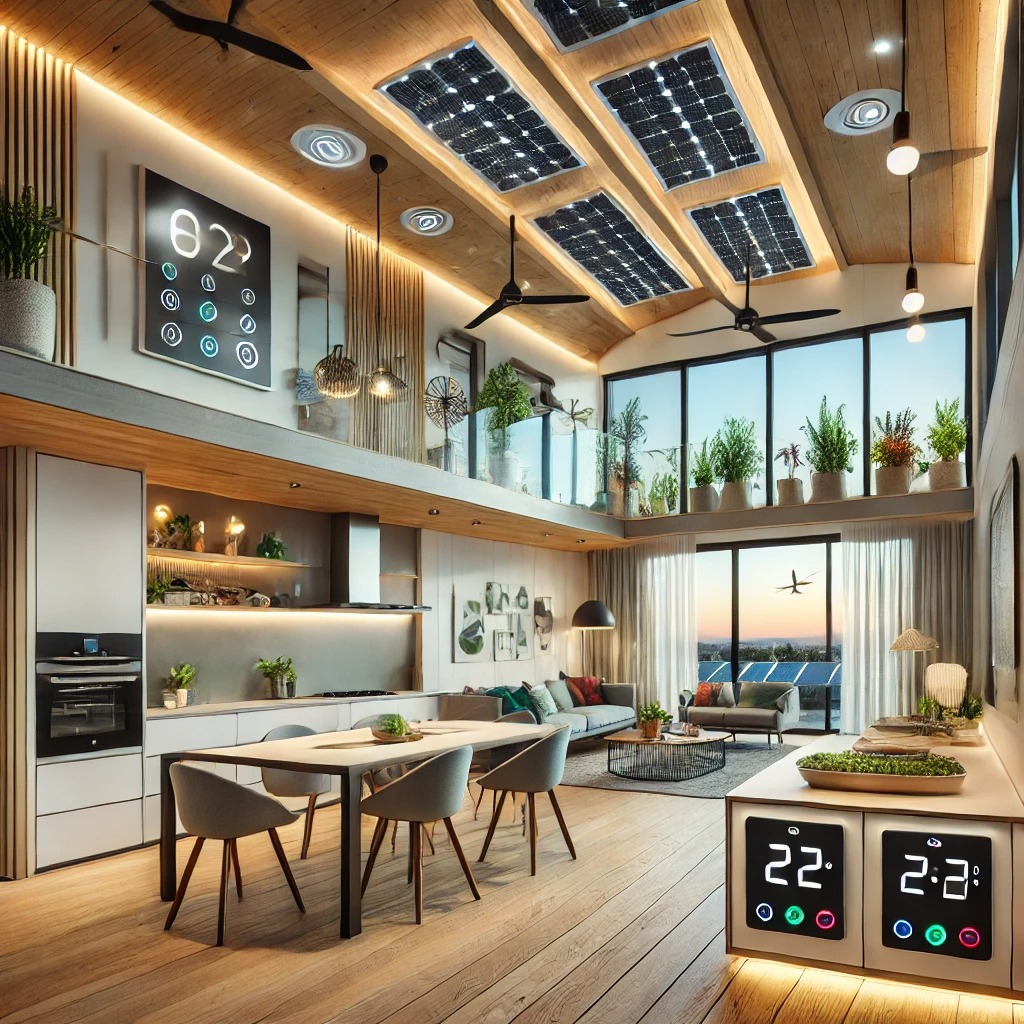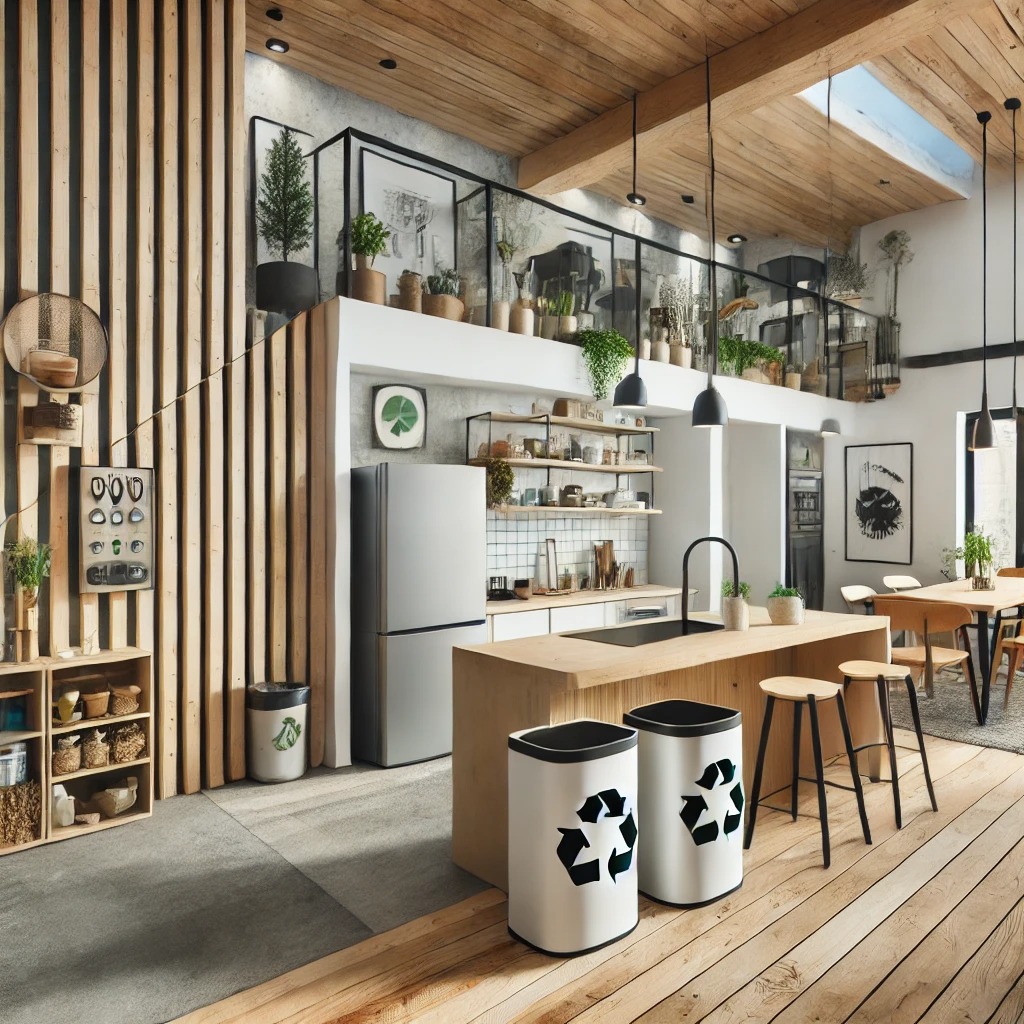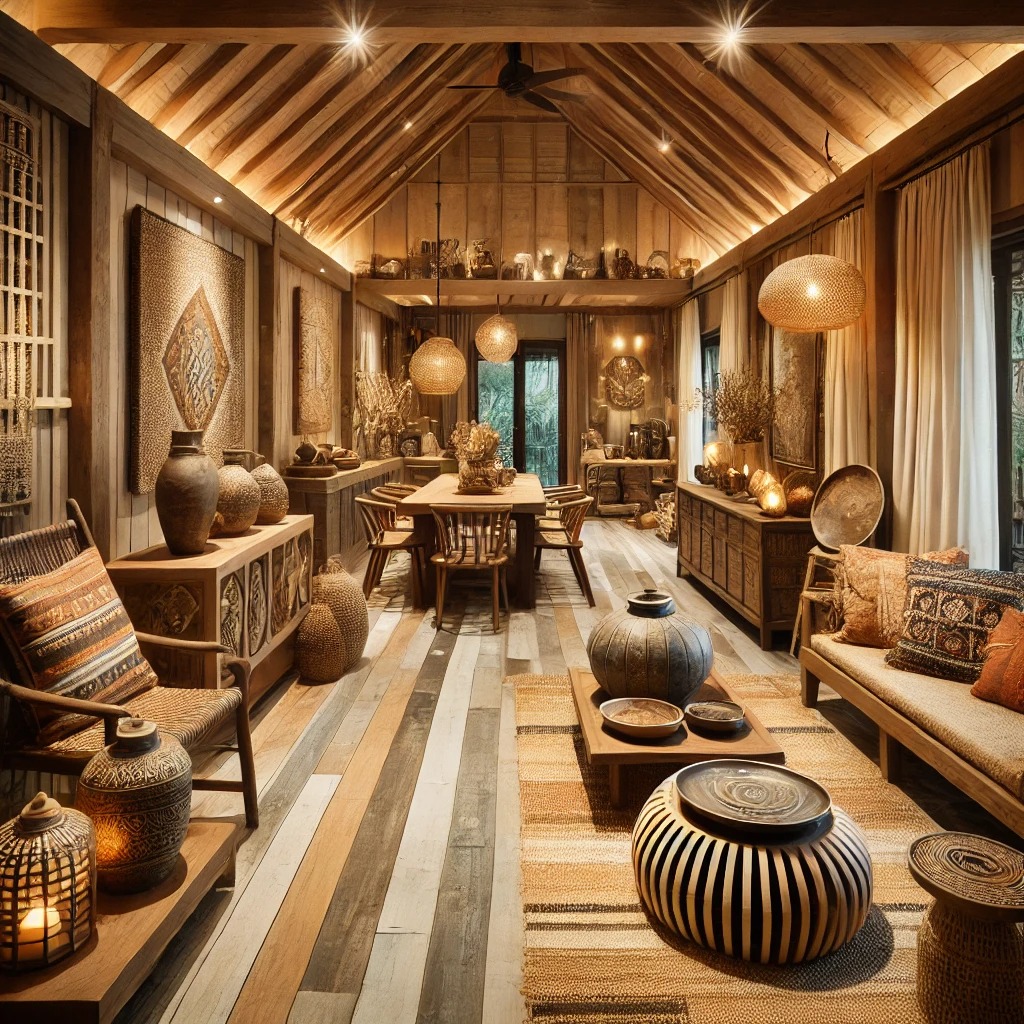OTD Interiors, based in Bangalore, is a distinguished interior design firm renowned for its commitment to eco-friendly and sustainable design practices. Their approach seamlessly blends aesthetics with environmental responsibility, ensuring that each project not only reflects creativity and innovation but also adheres to green principles.
Eco-Friendly Practices at OTD Interiors:
- Use of Sustainable Materials: OTD Interiors emphasizes the selection of environmentally friendly materials, such as bamboo, reclaimed wood, and low-VOC (volatile organic compounds) paints. This choice minimizes environmental impact and promotes healthier indoor air quality.

Sustainable materials are essential for eco-friendly interior design as they reduce environmental impact, improve indoor air quality, and promote energy efficiency. Here’s a detailed look at commonly used sustainable materials:
1. Bamboo
Bamboo is a fast-growing, renewable resource that is stronger than many hardwoods. It is used for flooring, furniture, and decorative panels. Durable, biodegradable, and rapidly renewable.
2. Reclaimed Wood
Instead of cutting down new trees, reclaimed wood is sourced from old buildings, barns, or furniture. Reduces deforestation, adds character and uniqueness.
3. Cork
Harvested from the bark of cork oak trees without harming the tree, cork is used for flooring, wall panels, and insulation. Sound-absorbing, hypoallergenic, and renewable.
4. Low-VOC Paints
Traditional paints release harmful chemicals (VOCs) that affect indoor air quality. Low-VOC or zero-VOC paints are a healthier alternative. Reduces air pollution and promotes better indoor air quality.
5. Recycled Metal & Glass
Using recycled aluminium, steel, and glass minimizes waste in landfills and reduces the need for raw material extraction. Highly durable and energy-efficient in production.
6. Natural Fabrics (Organic Cotton, Hemp, Linen, Wool)
Synthetic fabrics release microplastics and chemicals. Organic and natural fabrics are biodegradable and free from harmful dyes. Non-toxic, breathable, and biodegradable.
7. Recycled Plastic & Composite Materials
Repurposed plastic is transformed into furniture, tiles, and decor items. Reduces plastic waste and promotes circular economy.
- Energy-Efficient Solutions: Incorporating energy-efficient lighting, appliances, and HVAC systems is a cornerstone of their design philosophy. By optimizing natural light and ventilation, they reduce energy consumption and enhance the comfort of living spaces.

Energy-efficient solutions in interior design help reduce electricity consumption, lower utility bills, and minimize environmental impact. By incorporating smart technologies and sustainable materials, homes can become eco-friendlier and more cost-effective.
1. LED Lighting
Replacing traditional incandescent bulbs with LED lights significantly reduces energy use. LED bulbs consume up to 80% less energy and last longer. Low energy consumption, long lifespan, and reduced heat emission.
2. Smart Lighting & Motion Sensors
Smart lighting systems adjust brightness based on occupancy and natural light availability. Motion sensors automatically switch lights on and off as needed. Reduces unnecessary power usage and enhances convenience.
3. Solar Panels & Renewable Energy
Integrating solar panels helps generate clean, renewable energy for household needs. Reduces reliance on fossil fuels and lowers electricity bills.
4. Energy-Efficient Appliances
Using appliances with high energy ratings (like refrigerators, air conditioners, and /washing machines) ensures minimal power consumption. Look for Energy Star-certified appliances. Saves electricity and reduces carbon footprint.
5. Natural Ventilation & Insulation
Maximizing airflow through strategic window placement, cross-ventilation, and insulated walls minimizes the need for artificial cooling. Reduces reliance on air conditioning, lowers energy costs.
- Waste Reduction Strategies: OTD Interiors adopts practices like upcycling and repurposing existing furniture and materials, significantly reducing waste and promoting sustainability.

Waste reduction in interior design focuses on minimizing material waste, repurposing existing resources, and promoting sustainability. By implementing smart strategies, homeowners can create stylish spaces while reducing their environmental impact.
1. Upcycling & Repurposing Furniture
Instead of discarding old furniture, it can be refurbished, painted, or repurposed into something new. For example, an old wooden door can be transformed into a dining table. Reduces landfill waste and gives furniture a second life.
2. Use of Recycled Materials
Materials like reclaimed wood, recycled metal, and repurposed glass can be used in flooring, countertops, and décor. Lowers demand for new raw materials and conserves natural resources.
3. Modular & Multi-Functional Furniture
Investing in furniture with multiple uses (like a sofa bed or expandable dining table) reduces the need for excess furniture and promotes space efficiency. Saves space, reduces clutter, and minimizes material waste.
4. Minimalist Design Approach
A minimalist interior design focuses on essentials, reducing excess décor and unnecessary materials. Encourages mindful consumption and sustainable living.
5. Recycling & Composting
Sorting waste into recyclables, compostables, and non-recyclables helps manage waste effectively. Kitchen waste can be composted to create organic fertilizer. Reduces landfill waste and promotes a circular economy.
- Local Sourcing: Prioritizing locally sourced materials and collaborating with local artisans not only supports the regional economy but also reduces the carbon footprint associated with transportation.

Local sourcing in interior design refers to using materials, furniture, and decor that are produced or crafted within a nearby region. This approach supports local artisans, reduces transportation emissions, and promotes sustainability while maintaining a unique cultural touch in home interiors.
- Reduces Carbon Footprint: Locally sourced materials don’t require long-distance transportation, reducing fuel consumption and carbon emissions.
- Supports Local Artisans & Businesses: Purchasing handcrafted furniture, textiles, and decor from local craftsmen helps preserve traditional skills and supports the local economy.
- Ensures High-Quality & Unique Designs: Local artisans often create one-of-a-kind pieces with superior craftsmanship and attention to detail.
- Eco-Friendly & Sustainable Materials: Many locally sourced materials, such as reclaimed wood, natural stone, and bamboo, are more sustainable compared to mass-produced imports.
- Faster Availability & Customization: Working with local suppliers ensures quicker delivery and allows for customization to meet specific design needs.
- Promotes Cultural & Regional Aesthetics: Interiors can reflect the rich heritage and craftsmanship of the region, making spaces more meaningful and authentic.
Client-Centric Approach:
Understanding that each client has unique preferences and requirements, OTD Interiors offers personalized design solutions. Their team collaborates closely with clients to ensure that the final design aligns with their vision while incorporating eco-friendly elements.
Contact Information:
- Address: 1st Floor Gopalappa Complex, Sy.No.52/3, Ajjagondanahalli Road, Hoskote, Bengaluru, Karnataka 560087
- Email: info@otdinteriors.com
- Phone: +91 7008426277
For more information or to schedule a consultation, visit their official website: otdinteriors.com
By choosing OTD Interiors, clients in Bangalore can transform their spaces into aesthetically pleasing, functional, and environmentally responsible environments.
